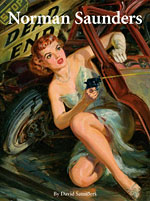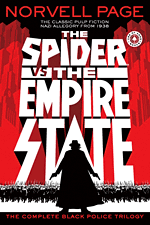
At $40, it’s not inexpensive, but what you’re investing in is a 12-by-9.25-inch, 368-page hardback book (and an inch-and-a-half thick, though I don’t judge a book by it’s thickness) that’s packed full of tremendous paintings displayed full page, or at least a quarter of a page. No thumbnails in this book.
Though pulp covers were only a small portion of the elder Saunders’ output, they are well represented here. A lot of pulp covers were the works of moderately talented folks. In this volume (if you hadn’t already realized it), it’s clear Saunders was a true artist.
For fans of pulp cover art, Norman Saunders is a book you shouldn’t pass up.

The book collects three stories from Popular Publication’s The Spider – “The City that Paid to Die,” “The Spider at Bay” and “Scourge of the Black Legion” – that appeared in the September, October and November 1938 issues.
A foreword by Thomas Krabacher, a professor at California State University, Sacramento, and a pulp collector, sets the scene for the Black Police trilogy by looking at current events during the 1930s. Profiles of Norvell Page, illustrator John Fleming Gould and cover painter John Newton Howitt, and a “Further Reading” section wrap up the 428-page book. (It’s over an inch thick, too. But, really, I don’t generally go around measuring the thickness of books.)
There are a number of The Spider novels that have been repeatedly reprinted. This is the first time these three stories have appeared in print since the pulps hit the newsstands over 71 years ago. For $17, you’ll be in for plenty of rousing pulp excitement.
– William

